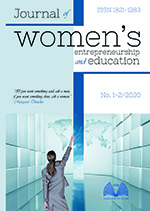Perspectives on Poverty by Gender within the Republic of Serbia
Main Article Content
Abstract
Gender poverty is a serious factor needing further examination and monitoring as related to economics since it is a limiting factor to an economy’s potential. Inequality is not only a sign of an unhealthy economy but of current and potential social discord. Serbia has tried to actively better the economic position of women by implementing its National Gender Equality Strategy 2009-2015. The paper deals with how gender affects poverty in Serbia. Using statistical data on indicators of gender poverty from 2016 to 2018, sourced from the Statistical Office of the Republic of Serbia, this paper presents an analysis of the economic position of women in the Republic of Serbia (RS). Recommendations for the advancement of women in RS in terms of their economic status are also provided.
Article Details
Section
Once the manuscript is accepted for publication, authors shall transfer the copyright to the publisher. If the submitted manuscript is not accepted for printing by the journal, the authors shall retain all their rights. The following rights on the manuscript are transferred to the publisher, including any supplementary materials and any parts, extracts or elements of the manuscript:
- the right to reproduce and distribute the manuscript in printed form, including print-on-demand;
- the right to print prepublications, reprints and special editions of the manuscript;
- the right to translate the manuscript into other languages;
- the right to reproduce the manuscript using photomechanical or similar means including, but not limited to photocopy, and the right to distribute these copies;
- the right to reproduce and distribute the manuscript electronically or optically using and all data carriers or storage media, and especially in machine readable/digitalized form on data carriers such as hard drive, CD-ROM, DVD, Blu-ray Disc (BD), Mini Disc, data tapes, and the right to reproduce and distribute the article via these data carriers;
- the right to store the manuscript in databases, including online databases, as well as the right to transmit the manuscript in all technical systems and modes;
- the right to make the manuscript available to the public or to closed user groups on individual demand, for use on monitors or other readers (including e-books), and in printable form for the user, either via the Internet, online service, or via internal or external networks.
Authors reserve the copyright to published articles and have the right to use the article in the same manner like third parties in accordance with the licence Attribution-Non-Commercial-Non-Derivate 4.0 International (CC BY NC ND). Thereby they must quote the basic bibliographic data of the source article published in the journal (authors, article title, journal title, volume, pagination).
References
Aisa, R., Larramona, G., Pueyo, F. 2019. “Poverty in Europe by gender: The role of education and labour”. Economic Analysis and Policy, vol. 63 (1), 24-34. Available at https://doi.org/10.1016/j.eap.2019.04.009
Babovic, M., Cvejic, S., Stefanovic, S. 2017. †žOprez, siromasÌŒtvo! – PracÌenje siromasÌŒtva u okviru razvojne agende UN do 2030. godine”. EAPN-Poverty-Watch-Serbia. Available at https://www.eapn.eu/wp-content/uploads/2017/12/EAPN-Poverty-Watch-Serbia-HR-2773.pdf
Burkevica, I., Humbert, A. L., Oetke, N., & Paats, M. 2015. “Gender gap in pensions in the EU”. Vilnius: EIGE.
DokmanovicÌ, M. 2016. †žGender Analysis for Serbia“. IBF Inter- national Consulting. Available at http://europa.rs/ files/Gender_Equality/Gender- Analysis-Serbia-dec-2016.pdf.
Eurostat. 2014. Working paper with the description of the “Income and living conditions dataset”. Available at https://ec.europa.eu/eurostat/documents/1012329/1012398/D5.1.3-Working_paper_final_20141204-QfyCdr1I.pdf
Gianni, B., Bettio, F., Georgiadis, T., & Tinios, P. 2015. “Unequal ageing in Europe: Women’s in- dependence and pensions”. New York: Palgrave Macmillan.
Government of the Republic of Serbia / Social Inclusion and Poverty Reduction Unit. (2018). The Third National Report on Social Inclusion and Poverty in the Republic of Serbia for the Period 2014-2017, http://socijalnoukljucivanje.gov.rs/wp-content/uploads/2019/02/Treci_nacionalni_izvestaj_o_socijalnom_ukljucivanju_i_smanjenju_siromastva_2014%E2%80%932017_eng.pdf
Harrington Meyer, M., Parker, W. M. 2011. “Gender, Ageing, and Social Policy”. In: Handbook of Ageing and Social Policy, 7th Edition, Binstock, R. H., George, K. L. (eds.). Amsterdam: Academic Press. Available at https://doi.org/10.1016/B978-0-12-380880-6.00023-X
Leskosek, V. 2018. “Poverty of Older Women in Slovenia“. Revija za socijalnu politiku, vol. 26 (2), 27-240. Available at doi: 10.3935/rsp.v26i2.1586
Matković, G. 2006. “Overview of poverty and social exclusion in the Western Balkans”. Stanovništvo, XLIV (1), 7-46. Available at https://doi.org/10.2298/STNV0601007M
Matković, G. Krstić, G., Mijatović, B. 2015. “Srbija: Prihodi i uslovi života 2013”. Statistical Office of the Republic of Serbia. Available at http://media.popispoljoprivrede.stat.rs/2014/12/Prihodi_i_uslovi_zivota_2013.pdf
National Strategy for Gender Equality 2016-2020, Serbia. Available at https://data.stat.gov.rs/Home/Result/18010403?languageCode=en-Latn
National Strategy for Gender Equality of RS 2009-2015. Available at http://www.atina.org.rs/sites/default/files/nacionalna_strategija%20za%20poboljsanje%20polozaja%20zena%20i%20unapredjivanje%20rodne%20ravnopravnosti.pdf
Ognjenović, K., Pavlović, D. 2019. “Are the self-employed at a higher poverty risk? Empirical evidence from Serbian SILC data.” Paper presented at the International Scientific Conference “Econometric Modelling in Economics and Finance”. Institute of Economic Sciences, Belgrade, October 29-30, 2019.
PantovicÌ, J, BradasÌŒ, S, Petovar, K. 2017. †žPolozÌŒaj zÌŒena na trzÌŒisÌŒtu rada“. Beograd: Friedrich Ebert Stiftung.
Schubert, G., Deimel, J. 2016. “Women in the Balkans / Southeastern Europe”. Leipzig: Biblion Media GmbH.
Stanković, B. 2014. “Lone mothers and their network support: Sociodemographic research of nonmarital parenthood in Serbia”. Stanovništvo, LII (1), 55-76. Available at https://doi.org/10.2298/STNV1401055S
Statistical Office of Republic of Serbia, Labor Force Survey 2016-2018. Available at https://publikacije.stat.gov.rs/G2020/PdfE/G20205658.pdf
Statistical Office of Republic of Serbia, SILC (2017), https://publikacije.stat.gov.rs/G2018/Pdf/G20181345.pdf
Statistical Office of Republic of Serbia. (2018). Statistical Yearbook of the Republic of Serbia 2018, https://publikacije.stat.gov.rs/G2018/Pdf/G20182051.pdf
United Nations. 2015. †žThe Millennium Development Goals Report”. Available at https://www.un.org/millenniumgoals/2015_MDG_Report/pdf/MDG%202015%20rev%20(July%201).pdf
Unterhalter, E. 2012. “Poverty, education, gender and the Millennium Development Goals: Reflections on boundaries and intersectionality”. Theory and Research in Education, 10 (3), 253-274. Available at https://doi.org/10.1177/1477878512459394
World Bank blog. 2018. Available at https://blogs.worldbank.org/developmenttalk/no-70-world-s-poor-aren-t-women-doesn-t-mean-poverty-isn-t-sexist
